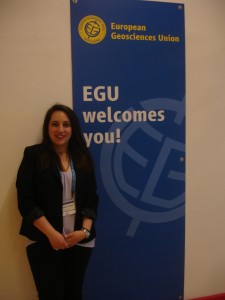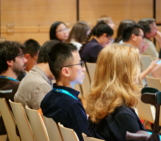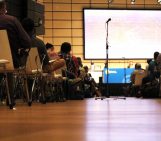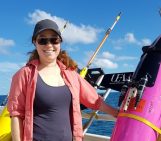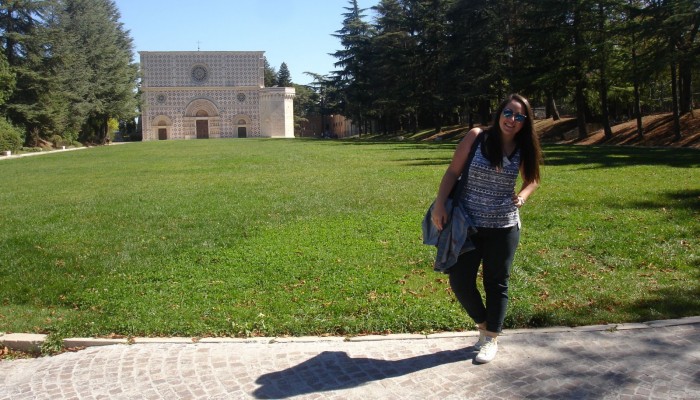
Weather – it dictates the clothes we wear, is engrained in our culture, shapes our seasons and plays an important role in our daily lives. Not only that, its long term forecast and understanding of its variability, is the focus of much research as it holds one of the keys to understanding the Earth’s past and future. Earthly weather has an altogether less familiar, but not less fascinating and important, extra-terrestrial cousin: space weather. In this month’s GeoTalk interview we talk to Anastasia Tezari, a masters student at the University of Athens, whose work on understating this phenomenon was recognised by the Solar Terrestrial Science Division at the 2015 General Assembly.
Anastasia, before we get going, can you tell us a little bit more about yourself and your research so far?
I hold a B.Sc. in Physics with a specialty in Nuclear and Particle Physics awarded by the National and Kapodistrian University of Athens, Greece. After attending many courses, I decided to select cosmic radiation as the main subject of my research. I received a proper training on experimental methods and gained significant research experience at the Athens Neutron Monitor Station (A.Ne.Mo.S.) in collaboration with the Neutron Monitor Database (NMDB) and as a member of the Athens Cosmic Ray Group, supervised by Emeritus Prof. Helen Mavromichalaki.
Currently, I am a M.Sc. student in the field of Environmental Health at the University of Athens Medical School, studying about the way environment impacts on our health, and specifically the biological effects of space weather. My research interests liein the field of cosmic radiation and space weather forecasting. Many technological and biological effects can be interpreted in terms of different solar and cosmic phenomena.
At the same time, I am also a private tutor for children for physics and maths. I really enjoy taking long walks with my dogs, trekking, going to concerts and travelling around the world!
As we touch upon in the introduction, most of us are very familiar with earthly weather. What is space weather and how is it different?
The term space weather was introduced in 1950s but it was not before 1990s that came to common usage. It describes the ways that the Sun and the solar wind specifically affect the environmental conditions in Earth’s atmosphere and magnetosphere and includes various solar and cosmic ray phenomena. These phenomena can have several impacts on earth’s climate, for example cloud formation, on technological systems, such as electronics on satellites and spacecrafts, communications systems and GPS, but can also have impacts on human health especially for astronauts and aircraft crews.
At the General Assembly in 2015, the Solar-Terrestrial Sciences Division awarded you with the Outstanding Student Poster Award for your work on cosmic radiation and space weather forecasting. Can you tell us a little more about the work you presented at the conference and its implications?
My work for the EGU2015 concerns the study of the Cosmic Ray Modulation and specifically the diurnal anisotropy of the cosmic ray intensity. Diurnal anisotropy is a short-term variation which is due to the rotation of the Earth around its axis and the way different places on Earth “measure” the cosmic ray intensity, as the geographic coordinates of the detectors are of great importance. In order to study the diurnal variation and its characteristics, we used data from the Neutron Monitor Stations of the University of Athens (Greece) and the University of Oulu (Finland), two stations of about the same geographic longitude but different geographic latitude.
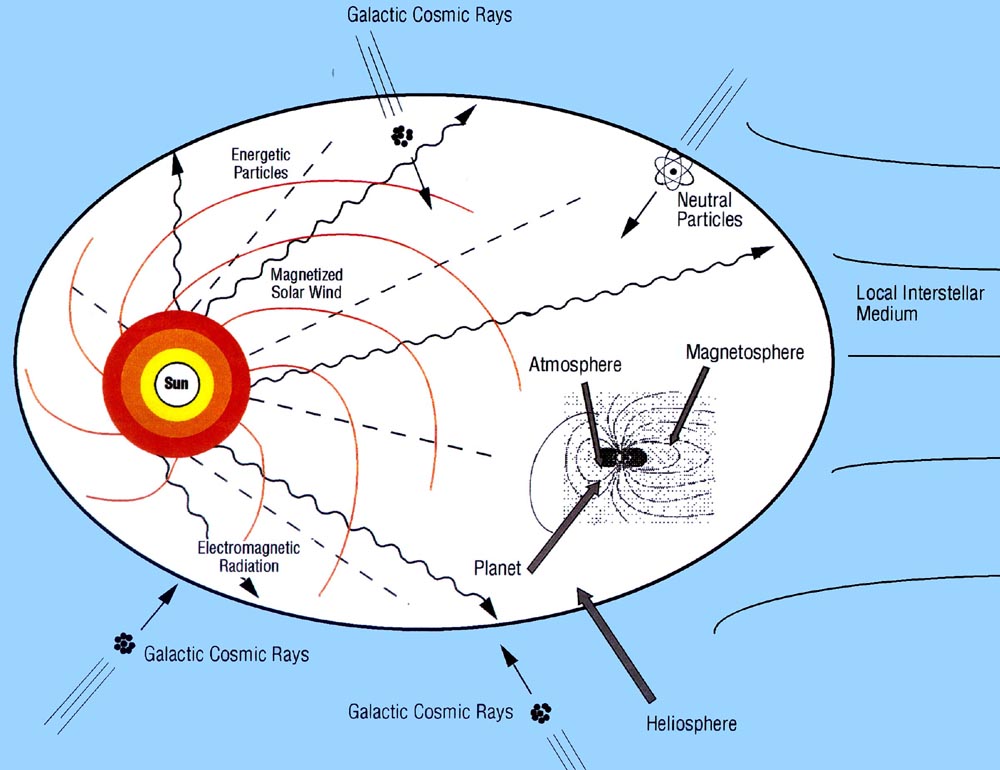
This is the Heliosphere, the outer atmosphere of the Sun, in which all the phenomena related to Space Weather take place. You can see the solar wind that streams to every direction in a spiral formation reaching the Earth that is rotating around its axis. This is the mechanism that creates the phenomenon of diurnal anisotropy of cosmic ray intensity.
The activity of the Sun changes periodically from maximum to minimum conditions forming the so- called solar cycle which is an 11-year variation. During the different phases of the solar cycle, diurnal anisotropy variations are observed, which are correlated to the solar cycle. There are also variations of the diurnal anisotropy during extreme solar and cosmic ray events, such as GLEs, Forbush decreases and geomagnetic storms, which are interpreted in different ways by each station.These results can be useful for long-term space weather monitoring and biomagnetic studies.
Today, ground based neutron monitors remain the state-of-the-art instrumentation for measuring cosmic rays. The Cosmic-Ray Station of the Athens University (A.Ne.Mo.S.) is unique in the Balkan area and the east part of the Mediterranean Sea and was among the first stations in the worldwide Neutron Monitor Network to provide real time data online. Since 2003, a data processing center (Athens Neutron Monitor Data Processing Center – ANMODAP) collecting data from 23 real time NM stations together with satellite data from ACE (Advanced Composition Explorer) & GOES (Geostationary Satellite Server) is operated at the Athens NM station. Today it provides accurate data with resolution up to 1 sec and a real time GLE-Alert System, which is a Ground Level Enhancement alarm system.
Most attendees at the EGU General Assembly are at PhD level, or above. The EGU encourages the attendance of both undergraduate and masters students to the conference. As a masters student, how did you find the experience of presenting at an international conference?
The EGU2015 is actually the first conference (national or international) that I participated actively via a poster presentation. In the beginning, I was really anxious about doing this and was definitely out of my comfort zone, but due to the huge support of my professor and friends, I took the big step. The experience was really rewarding as I had the chance to defend my work for the first time and interact with so many scientists from different disciplines and different countries. Despite the size of the event, it was organised very well, so I was able to attend many workshops and follow all the breakthroughs in science. I also got to see Vienna, which I can confirm is one of the most beautiful capitals of Europe and made a lot of new “international” friends!
Do you have any words of advice for students who are planning on attending the EGU 2016 General Assembly?
The advice is one and only: you definitely have to attend the EGU2016! It is by far the greatest conference you will be able to participate. It is a great chance to exchange knowledge and ideas with so many other scientists, as well as get advice that can contribute to your studies and research from different scientific fields. So, continue doing what you really enjoy, work hard and don’t wait to reach a PhD level in order to participate in such a conference. Just be well-prepared as the questions concerning your work can be really tough! And don’t forget to enjoy yourself in Vienna!

